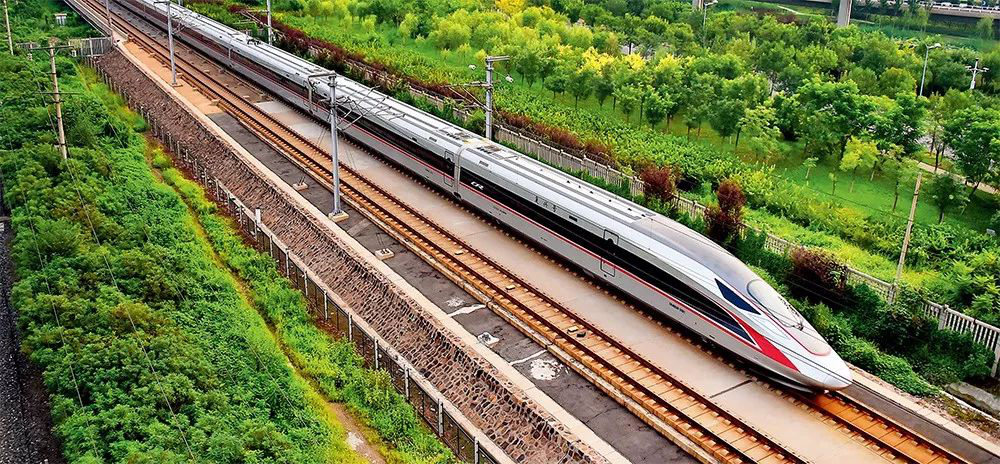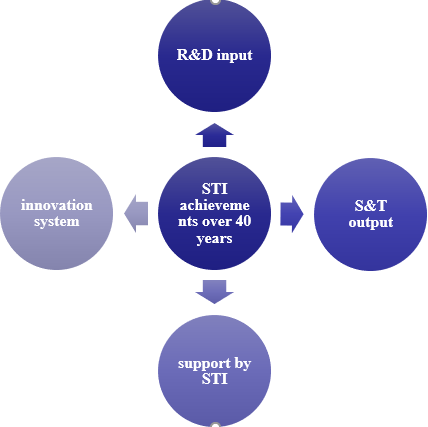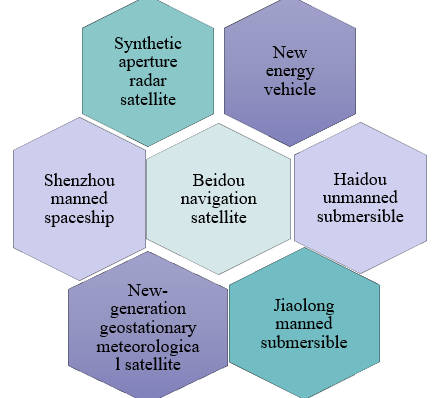| STI achievements over 40 years since reform and opening up in China |
| 2018-12-05 22:30 |

(This article comes from the Report on STI Achievements over 40 years since Reform and Opening-up released by National Bureau of Statistics.The pictures are from the Outlook Weekly, No.24 2018. ) Over the past 40 years, China has witnessed dramatic changes in science and technology. The S&T strengths is being enhanced along with economic rise, underpinning the improvement of China's comprehensive national strengths. Particularly since the 18th National Congress of the CPC, the innovation-driven development strategy has been implemented on all fronts, the reform on S&T system further deepened, R&D input increased continuously, innovation vitality stimulated, major outcomes created constantly and relevant systems improved gradually. China is witnessing rapid S&T development, becoming a big STI country with global impact. This article deals with four aspects, namely R&D input, S&T output, innovation system and support by STI.
I. S&T input 1. R&D personnel In 2017, China had a total of 6.214 million R&D personnel or 4.034 million FTE R&D personnel, six times that of 1991. Its annual average growth rate from 1992 to 2017 reached 7.1%. 2. R&D expenditure Since reform and opening–up, the R&D expenditure has seen sustained and rapid growth. In 2017, it stood at 1.7606 trillion yuan, 123 times that of 1991. And the annual average growth rate reached 20.3% from 1992 to 2017, 5.3 percentage points higher than annual average GDP growth rate in the same period. This has provided strong funding guarantee for STI development in China. 3. R&D intensity R&D intensity (the ratio of R&D expenditure to GDP) is an internationally used core indicator for reflecting the S&T input of a country. Since reform and opening-up, the R&D intensity has reached higher and higher levels. It exceeded 1% for the first time in 2002, reached 2.02% in 2014 and rose to 2.13% in 2017. We have generally surpassed the average level of 15 EU countries [1], reaching the level of medium-developed countries. 4. S&T program Over the 40 years since reform and opening-up, China has put in place a series of development programs in multiple areas such as basic research (973 Program), hi-tech research (863 Program), science infrastructure and transformation of S&T achievements, set up an open and unified national management platform of S&T programs and contributed to a huge leap in S&T strengths. The constantly increasing S&T input has dramatically improved science infrastructure, leading to a well-established research environment consisting of mega-science equipment and devices, state key labs, science data libraries, industrial technology platforms and enterprises' technology centers. By the end of 2017, there have been a total of 503 state key labs, 131 national engineering research centers, 217 national engineering labs and 1,276 national enterprises' technology centers. Research infrastructure has been improved continuously. II. S&T output 1. Fruitful outcomes in science paper publication In 2016, Chinese science journals published 494,000 papers, 5.5 times that of 1990. The three foreign major search engines - SCI, EI and CPCI, collected 324,000, 227,000 and 86,000 Chinese science papers, respectively ranking No.2, No.1 and No.2 in the world. 2. Greater performance in both quality and quantity of patents In 2017, Chinese patent applications reached 3.698 million, 74 times that of 1991 and with an annual average growth rate of 18.0% from 1992 to 2017. The Chinese patent authorizations reached 1.836 million, 75 times that of 1991 and with an annual average growth rate of 18.1%. While increasing in terms of quantity, the patents have also witnessed quality enhancement at the same time. Take invention patent, the best indicator of innovation level, as an example, in 2017 the Chinese invention patent applications reached 1.382 million, 37.4% of the total patent applications and 14.6 percentage points higher than 1991. 70 domestic invention patents in every 100 million yuan were applied, up by 19 compared with 1991. The efficiency of patent creation has been increased. 3. IPR China has ranked the world's No.1 in terms of invention patent applications for seven consecutive years by the end of 2017 and No.2 in international patents applied through PCT last year. In 2017, China received 5.748 million applications for trademark registration, No.1 in the world; the yearly copyright registration exceeded 2.748 million, and the registration of copyright of the works and that of computer software stood at respectively 2.002 million and 745,000. The country gives great prominence to IP protection and utilization, as a number of laws and regulations such as Trademark Law, Patent Law, Copyright Law and the Law on Transformation of S&T Achievements have been promulgated to improve protection mechanisms and strengthen law enforcement. By the end of 2017, China has established 3 IP courts and many IP tribunals, 19 IP protection centers and 76 rights protection centers. The society is becoming more and more satisfied with IP protection. 4. Hi-tech achievements Thanks to the support of National Major S&T Projects and National High-tech R&D Program, China has seen booming hi-tech outcomes.
The Chinese government puts basic research high on its agenda. In 2017, the basic research expenditure stood at 97.55 billion yuan, 54 times that of 1995. The annual average growth rate from 1996 to 2017 reached 19.9%. III. Innovation System 1. Mass entrepreneurship and mass innovation is advanced extensively In 2017, 53,000 market players of all kinds including enterprises and individually-owned businesses were founded each day on average, among which 17,000 were enterprises, up by 9.9% and 16.6% respectively compared with 2016. By the end of 2017, there have been 98.15 million market players of all kinds, 11,630 enterprises in NEEQ, 690 enterprises in GEM and 164 unicorn enterprises. An increasingly large number of makers, innovators and average citizens have been involved in mass entrepreneurship and mass innovation.
2. Markedly closer cooperation between enterprises, universities and research institutes In 2017, among the 201,000 enterprises above designated scale devoted to product or technique innovation, 20.3% chose universities as their partners and 12.1% chose research institutes for cooperation. In 2017, enterprises above designated scale allocated a total of 34.26 billion yuan of R&D funding to research institutes and universities, an increase of 35.7% compared with 2012. 3. Faster development of S&T intermediary service By the end of 2017, there have been 5,739 makers' spaces on the record and over 4,700 S&T incubators and accelerators of all kinds, which served as platforms of cooperation between various innovation players. The reform on S&T system revitalized technology market transactions and substantially facilitated the reasonable use and transformation of China's STI resources. In 2017, 368,000 deals were made in technology markets across the country, covering technology development, technology transfer and technology consulting and services. The total transaction volume reached 1.3424 trillion yuan, 142 times that of 1991 and each contract volume 3.65 million yuan on average, 80 times that of 1991. 4. Regional innovation coordination National hi-tech zones are the main bases of regional innovation development. In recent years, efforts have been stepped up in establishing hi-tech zones, as the number of the zones has increased from 27 in 1990 to 168 in 2017. IV. Stronger support by STI 1. STI provides specialized services China has constantly improved its specialized technology services in areas of quality control, meteorology, seismology and mapping. By the end of 2017, China has had a total of 35,000 product testing labs and 401 product quality and system certification agencies accomplishing product certification for 140,250 companies altogether. In 2016, the National Meteorological Center and provincial centers gave 8,551 pre-warnings and 6,069 alarms. By the end of 2017, the country has had 1,668 seismic stations, 32 regional seismic networks, 124 ocean stations (points), 1,513 maps published by mapping authorities and nearly 600 science museums of all kinds providing science popularization services for over 50 million people each year. 2. STI development underpins major projects Since reform and opening-up, China has witnessed remarkable improvement in the self-development capacity and level of complete systems of major products and major technology equipment, which has concretely supported engineering projects and events of national significance such as Three Gorges Dam, Qinghai-Tibet Railway, West-east Natural Gas Transmission, South-North Water Diversion, Olympic Games and Shanghai Expo. STI has played a pioneering role in dealing with economic restructuring, quality and efficiency enhancement, three rural issues, social development and improvement of people's well-being, and a supporting and leading role in resolving major problems of energy conservation and emission reduction, climate change, emergency disaster relief and epidemic disease prevention and treatment. As has been estimated, the contribution rate of science and technology has increased from 43.2% in 2005 to 57.5% in 2017. And the economic pattern featuring transition from factor-driven to innovation-driven is being advanced in a steady manner. 3. STI promotes international exchange Thanks to rapid development over the 40 years, China further expanded and deepened its international cooperation in science and technology. At present, China has set up S&T partnerships with 158 countries and signed 113 inter-governmental agreements. The integration of bringing in and going global and the launch of Belt and Road Initiative STI Action Plan have ushered in the normalcy of technology introduction and spillover in all areas. S&T diplomacy has become an important component of national overall diplomatic strategies. 4. STI optimizes industrial structure In 2017, the hi-tech manufacturing industry above designated scale realized a prime operating revenue of 15.9 trillion yuan, an increase of 55.8% compared with 2012 and an annual average growth rate of 9.3%, 5.2 percentage points higher than that of the industries above designated scale in the same period last year. The rapid development of hi-tech manufacturing industries results from constant increase in R&D input. In 2017, the R&D expenditure for hi-tech manufacturing industry stood at 318.3 billion yuan, up by 83.6% compared with 2012 and an annual average growth of 12.9%, 2.1 percentage points higher than that of the industries above designated scale in the same period last year; the R&D intensity was 2.0%, 1.9 times that of the average industrial level. Note: [1] 15 EU countries: Austria, Belgium, Luxemburg, Denmark, Finland, France, Germany, Greece, Ireland, Italy, Netherlands, Portugal, Spain, Sweden and the UK. |
| |||||||||||||
|







